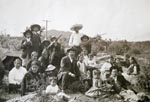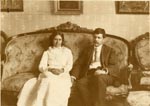Travels of the Fine Artist
Candelario Rivas moved his family throughout the central Mexican states to secure the highest paying commissions in commercial and religious art. Starting out in Zacatecas, the family's first move was to San Luis Potosí in 1901. Late in the following year, the family moved to the largest city in the region, León, which had already become the economic and agricultural trade center for the central states. The six murals in the city's redecorated Catedral Basílica consumed most of the artist's time in 1903 and 1904. He continued with commercial and private commissions through the family's move north to the city of Aguascalientes in 1905, and completed the twelve murals in the Templo de San Antonio in 1907. By 1908, the family was back in León, and stayed there until 1913 before a brief one or two year stay in Querétaro
Between 1915 and 1920, we are not exactly sure where the Rivas family was situated. We know that Herlinda loved to talk about Morelia in her later years, and so the family may have spent an extended visit there. Other art historians have informed us of large religious murals completed in convents located somewhere in the state of Guanajuato. And from photographs and known commissions, we can conclude that the Rivas family lived in the cities of León and Zacatecas during those turbulant years of Mexican history. In 1920, the family moved to Salamanca, where Candelario and his now twenty- year old son, José, worked almost continually on the magnificent murals in the Catedral Señor del Hospital in Salamanca, and the Santiago Apóstol Church in Valle de Santiago.
In September of 1923, at the age of forty-six, and with Herlinda eight months along with their third daughter, Candelario fled the political unrest in Mexico. Briefly stopping in the city of Zacatecas to protect his murals from being confiscated by the federal government in the Santuario de Guadalupe Church, Candelario took the train with his family to El Paso, Texas. From there, the Rivas family took the new Electric Train to Los Angeles, where the great artist would live the rest of his life.
León
For over one hundred years, the city of León has remained one of Mexico's most important industrial centers. Fine leather goods and a strong manufacturing base provided León with a robust economic foundation to support rich designs in architecture and art. Candelario lived with his family there from 1902 to 1905, and again from 1908 until 1913. These were prosperous years for the Rivas family, as well. Their first daughter Manuela was born during the family's first residency there, and Salvador was born during their second stay. In 1902, Candelario received a handsome commission to complete six large murals in the city's Catedral Basílica.
Situated twenty feet high on the ornate side walls of the church, they show an exceptional texture of his hallmark colors of red-orange, light-green and purples. Directed by the church's art director, Luis G. Orozco, the twenty-four year old Candelario Rivas painted with a richness of illustrative story- telling which continues to fascinate visitors to this day. Family notes indicate that the Catholic Church was very pleased with Candelario's rendition of religious historical events, and continued to assist him with training in the early years, and with important commissions in the later years. To this day, in the Vatican there is a small watercolor of Our Lady of Guadalupe by Candelario Rivas. He was commissioned by the bishop of León to replicate the revered religious image for an album to be presented by the diocese to His Holiness, Pope Leo XIII.
Candelario also completed many portraits during the latter years in León. Besides the immense murals in the Catedral Basílica, Candelario worked on a large commission for the church of the Third Order of St. Francis just two blocks away in the northwest corner of the city's main plaza. But when the Franciscans vacated this church just prior to 1950, they removed all of his artwork. These paintings have yet to be found by the Rivas family.

On Herlinda's thirty-second birthday, Candelario presented her with a gold medallion of the Sacred Heart. The back (as shown) is inscribed with her initials; "HR". And in the center is inscribed; "León 9-22, 1912"
In his early days as an artist in León and Aguascalientes, Candelario maintained his reputation as a fine photographer, and master of developing and printing. With cameras bought in Mexico City, he supplemented his income with photographic portrait work. Shown are photographs he took of three of his children.





